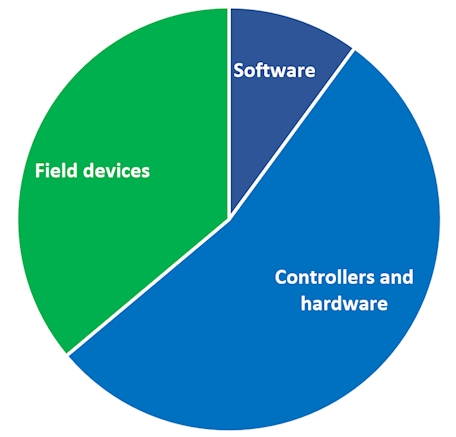Building Automation and Controls in light commercial buildings
New BSRIA Worldwide Market Intelligence (WMI) study covering Germany, Italy, France, and the UK estimates the market for building automation controls in light commercial buildings at EUR 275 million in 2022.
The building automation software, controllers, hardware, and field devices installed in light commercial buildings account for a significant share of overall BACS product sales in the four major European markets estimated at EUR 1.1 billion.
Most BACS products installed in light commercial buildings are found in offices, with 40-50% share, followed by hotels, education, health, retail and mixed-use buildings with some variation in each country.

|
| Source: BSRIA Worldwide Market Intelligence |
It is also worth noting that building automation controls products sold to the light commercial building segment are expected to grow at a higher rate than the overall BACS market, particularly in 2024 and 2025 with 11% and 13% respectively. Most of the European economies showed good economic growth in 2021, but Russia's invasion of Ukraine is increasingly impacting economies in 2022.
On the positive side, the European Energy Performance of Buildings Directive (EPBD) drives the adoption of BACS to optimise energy use through better automation, control, and monitoring. In December 2021, the European Commission proposed a new directive that states that non-residential buildings will have to be renovated and improved to at least energy performance grade F by 2027 and grade E by 2030 as part of European Union’s net zero-emission strategy.
Over half the sales are accounted for by controllers and hardware, followed by field devices, and then software.

|
| Source: BSRIA Worldwide Market Intelligence |
BSRIA WMI's BACS in Light Commercial Buildings study includes products falling within the following definitions:
- Professionally installed systems.
- A minimum of two or more interconnected systems (HVAC, lighting, blinds, occupancy sensors, security etc.).
- Open systems/platforms with protocols such as KNX, BACnet and LON.
- Wired controllers/systems with the capability to integrate wireless devices and cloud connection.
- Most systems installed in buildings with floor space below 25,000 sq. ft or 2,323 m2.
The value is in Manufacturer Selling Prices (MSP) covering products (not labour). The study does not cover plug & play products installed in the residential market, nor does it cover systems connected to big plant equipment.
The study is part of BSRIA WMI’s BACS and Smart building portfolio, which includes world studies on building automation and publications on field devices (valves, actuators and sensors). BSRIA WMI is a leading provider of studies covering building services such as structured cabling, building controls, air conditioning, ventilation, refrigeration & refrigerants, and heat pumps.
This article originally appeared on the BSRIA News and Blog site under the same title dated August 2022.
--BSRIA
[edit] Related articles on Buildings Design
- BACS building automation controls - the information revolution.
- BS EN 15232 Energy performance of buildings: impact of building automation, controls and building management.
- BSRIA articles.
- Building management systems BMS.
- Intelligent building management systems IBMS.
- Use class designation for land and buildings.
Featured articles and news
Energy industry calls for urgent reform.
Heritage staff wellbeing at work survey.
A five minute introduction.
50th Golden anniversary ECA Edmundson apprentice award
Showcasing the very best electrotechnical and engineering services for half a century.
Welsh government consults on HRBs and reg changes
Seeking feedback on a new regulatory regime and a broad range of issues.
CIOB Client Guide (2nd edition) March 2025
Free download covering statutory dutyholder roles under the Building Safety Act and much more.
AI and automation in 3D modelling and spatial design
Can almost half of design development tasks be automated?
Minister quizzed, as responsibility transfers to MHCLG and BSR publishes new building control guidance.
UK environmental regulations reform 2025
Amid wider new approaches to ensure regulators and regulation support growth.
The maintenance challenge of tenements.
BSRIA Statutory Compliance Inspection Checklist
BG80/2025 now significantly updated to include requirements related to important changes in legislation.
Shortlist for the 2025 Roofscape Design Awards
Talent and innovation showcase announcement from the trussed rafter industry.
OpenUSD possibilities: Look before you leap
Being ready for the OpenUSD solutions set to transform architecture and design.
Global Asbestos Awareness Week 2025
Highlighting the continuing threat to trades persons.
Retrofit of Buildings, a CIOB Technical Publication
Now available in Arabic and Chinese aswell as English.
The context, schemes, standards, roles and relevance of the Building Safety Act.
Retrofit 25 – What's Stopping Us?
Exhibition Opens at The Building Centre.
























